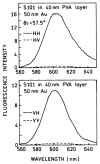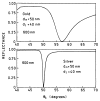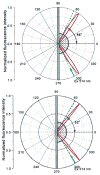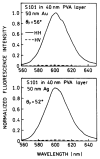Surface Plasmon-Coupled Emission with Gold Films
- PMID: 20729993
- PMCID: PMC2924592
- DOI: 10.1021/jp040221h
Surface Plasmon-Coupled Emission with Gold Films
Abstract
In a recent report we demonstrated efficient collection of emission by coupling to surface plasmons on a thin silver film, resulting in a directional signal in the glass substrate. We call the phenomenon surface plasmon coupled emission (SPCE). In the present report we examined sulforhodamine 101 (S101) in thin polymer films on 50 nm thick gold films on glass. We observed efficient SPCE through thin gold films. This result was surprising because metallic gold is typically an efficient quencher of fluorescence. The energy effectively coupled through the gold film into the glass at a sharply defined angle, but somewhat less sharp than for a comparable silver film. About 50% of the total emission appeared as SPCE, irrespective of direct excitation or excitation via the plasmon resonance evanescent wave. The emission was p-polarized with different wavelengths appearing at different angles. The lifetime of S101 was mostly unaffected by the gold film. These results indicate that SPCE occurs over long distances, larger than for quenching by energy transfer to the gold. We conclude highly efficient detection devices can be constructed by using fluorophores on gold-coated surfaces.
Figures











Similar articles
-
Radiative decay engineering 4. Experimental studies of surface plasmon-coupled directional emission.Anal Biochem. 2004 Jan 15;324(2):170-82. doi: 10.1016/j.ab.2003.09.036. Anal Biochem. 2004. PMID: 14690680 Free PMC article.
-
Ultraviolet surface plasmon-coupled emission using thin aluminum films.Anal Chem. 2004 Jul 15;76(14):4076-81. doi: 10.1021/ac040004c. Anal Chem. 2004. PMID: 15253645 Free PMC article.
-
Radiative decay engineering 3. Surface plasmon-coupled directional emission.Anal Biochem. 2004 Jan 15;324(2):153-69. doi: 10.1016/j.ab.2003.09.039. Anal Biochem. 2004. PMID: 14690679 Free PMC article.
-
Plasmonic technology: novel approach to ultrasensitive immunoassays.Clin Chem. 2005 Oct;51(10):1914-22. doi: 10.1373/clinchem.2005.053199. Epub 2005 Jul 28. Clin Chem. 2005. PMID: 16055432 Free PMC article. Review.
-
Surface plasmon-coupled emission: what can directional fluorescence bring to the analytical sciences?Annu Rev Anal Chem (Palo Alto Calif). 2012;5:317-36. doi: 10.1146/annurev-anchem-062011-143208. Epub 2012 Apr 9. Annu Rev Anal Chem (Palo Alto Calif). 2012. PMID: 22524220 Review.
Cited by
-
When are surface plasmon polaritons excited in the Kretschmann-Raether configuration?Sci Rep. 2015 Apr 23;5:9929. doi: 10.1038/srep09929. Sci Rep. 2015. PMID: 25905685 Free PMC article.
-
Surface Plasmon-Coupled Ultraviolet Emission of 2,5-Diphenyl-1,3,4-oxadiazole.J Phys Chem B. 2004 Dec 16;108(50):19114-19118. doi: 10.1021/jp047136u. J Phys Chem B. 2004. PMID: 20725614 Free PMC article.
-
Aluminum nanoparticles as substrates for metal-enhanced fluorescence in the ultraviolet for the label-free detection of biomolecules.Anal Chem. 2009 Feb 15;81(4):1397-403. doi: 10.1021/ac802118s. Anal Chem. 2009. PMID: 19159327 Free PMC article.
-
Radiative decay engineering 4. Experimental studies of surface plasmon-coupled directional emission.Anal Biochem. 2004 Jan 15;324(2):170-82. doi: 10.1016/j.ab.2003.09.036. Anal Biochem. 2004. PMID: 14690680 Free PMC article.
-
First Observation of Surface Plasmon-Coupled Chemiluminescence (SPCC).Chem Phys Lett. 2007 Feb 12;435(1-3):114-118. doi: 10.1016/j.cplett.2006.12.063. Chem Phys Lett. 2007. PMID: 18268785 Free PMC article.
References
Grants and funding
LinkOut - more resources
Full Text Sources
Other Literature Sources
Miscellaneous
